Main Article Content
Abstract
Stress is a body response that is not specific to problems or burdens, feelings of discomfort, or pressure, both physical and psychological as an individual response, online guidance that is felt to lack interaction between lecturers and students can form a learning process. This study aims to see the relationship between thesis guidance through online media and the level of stress of the eighth semester nursing students at the Immanuel College of Health, Bandung. This research is a type of quantitative research that uses a cross sectional approach. The sample in this study may be 42 respondents using total sampling technique. The instrument used was a questionnaire instrument to measure stress levels using DASS 42 and online guidance using a closed questionnaire. The results of the analysis of this study using the Spearman Rank test indicate that there is a relationship between thesis guidance through online media with the stress level of semester VIII nursing students at Immanuel College of Health Sciences Bandung (p-value 0.000 <0.05). Suggestions are expected to align online and offline thesis guidance activities carried out by lecturers with the distribution of the proportions, so that it can make it easier for lecturers to evaluate students' understanding of the preparation of final study assignments (Thesis) and can reduce stress that has a negative impact on students.
Keywords
Article Details
References
- Adijaya N, Pudji L. (2018). Persepsi Mahasiswa Dalam Pembelajaran Online: ejournal Wanastra vol 10 No. 2 hal 105-110.
- Aini, Nur. (2018). Teori Model Keperawatan. Malang: Universitas Muhammadiyah Malang.
- Arikunto,S. (2013). Prosedur Penelitian Suatu Pendekatan Praktik. Edisi Revisi. Jakarta: PT. Rineka Cipta.
- Azwar, S. (2013). Metode Penelitian. Yogyakarta: Pustaka Pelajar
- Damanik, E.D. (2014). Damanik translation Bahasa Indonesia. Dalam : Psychology Foundation of Australia. Depression Anxiety Stress Scale (DASS). Diakseshttp://www2.psy.unsw.edu.au/dass/Indonesian/Damanik.htm
- Dwiyani, Aprillita. (2013). Perancang Sistem Pendukung Bimbingan Online Tugas Akhir Mahasiswa Program Studi Teknik Informatika, hal 1-5. Jurnal PalangkaRaya
- Febriani, Deni. (2011). Bimbingan dan Konseling. Yogyakarta: Teras
- Gamayanti, Witrin dkk. (2018). Self Disclosure dan Tingkat Stres pada Mahasiswa yang sedang Mengerjakan Skripsi. Hal 1-16. Jurnal Ilmiah Psikologi
- Nasrullah, Rulli. (2015). Media Sosial Perspektif Komunikasi, Budaya dan Sosioteknologi. Bandung: Simbiosa Rekatama Media
- Puspitasari. (2013). Hubungan antara Manajemen Waktu dan Dukungan Sosial dengan Prestasi Akademik Mahasiswa yang Bekerja. EMPATHY Jurnal Fakultas Psikologi
- R, Aditya. (2015). Pengaruh Media Sosial Instagram Terhadap Minat Fotografi pada Komunitas Fotografi Pekan Baru. Pekanbaru: JomFISIP vol.2
- Riyanto. (2013). Aplikasi Metodologi Penelitian Kesehatan. Yogyakarta: Nuha Medika.
- Simanihuruk, Lidia., et al. (2019). E-learning: Implementasi, Strategi, dan Inovasinya. Medan: Yayasan Kita Menulis.
- Sumantri, Syarif. (2014). Strategi Pembelajaran. Jakarta: Rajawali Pers
References
Adijaya N, Pudji L. (2018). Persepsi Mahasiswa Dalam Pembelajaran Online: ejournal Wanastra vol 10 No. 2 hal 105-110.
Aini, Nur. (2018). Teori Model Keperawatan. Malang: Universitas Muhammadiyah Malang.
Arikunto,S. (2013). Prosedur Penelitian Suatu Pendekatan Praktik. Edisi Revisi. Jakarta: PT. Rineka Cipta.
Azwar, S. (2013). Metode Penelitian. Yogyakarta: Pustaka Pelajar
Damanik, E.D. (2014). Damanik translation Bahasa Indonesia. Dalam : Psychology Foundation of Australia. Depression Anxiety Stress Scale (DASS). Diakseshttp://www2.psy.unsw.edu.au/dass/Indonesian/Damanik.htm
Dwiyani, Aprillita. (2013). Perancang Sistem Pendukung Bimbingan Online Tugas Akhir Mahasiswa Program Studi Teknik Informatika, hal 1-5. Jurnal PalangkaRaya
Febriani, Deni. (2011). Bimbingan dan Konseling. Yogyakarta: Teras
Gamayanti, Witrin dkk. (2018). Self Disclosure dan Tingkat Stres pada Mahasiswa yang sedang Mengerjakan Skripsi. Hal 1-16. Jurnal Ilmiah Psikologi
Nasrullah, Rulli. (2015). Media Sosial Perspektif Komunikasi, Budaya dan Sosioteknologi. Bandung: Simbiosa Rekatama Media
Puspitasari. (2013). Hubungan antara Manajemen Waktu dan Dukungan Sosial dengan Prestasi Akademik Mahasiswa yang Bekerja. EMPATHY Jurnal Fakultas Psikologi
R, Aditya. (2015). Pengaruh Media Sosial Instagram Terhadap Minat Fotografi pada Komunitas Fotografi Pekan Baru. Pekanbaru: JomFISIP vol.2
Riyanto. (2013). Aplikasi Metodologi Penelitian Kesehatan. Yogyakarta: Nuha Medika.
Simanihuruk, Lidia., et al. (2019). E-learning: Implementasi, Strategi, dan Inovasinya. Medan: Yayasan Kita Menulis.
Sumantri, Syarif. (2014). Strategi Pembelajaran. Jakarta: Rajawali Pers
